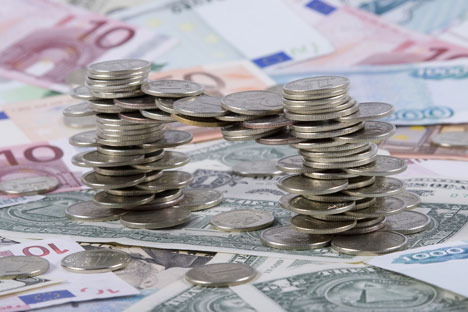
The ruble-to-dollar exchange rate continued to fall in early August, despite high oil prices, which have returned to the area of $108 per barrel. Source: PhotoXpress
In early August, the Central Bank of Russia reported on July currency interventions. It sold $4.2 billion and €374 million—the largest volume since October 2011. The greatest part ($3.1 billion) consisted of planned interventions, the volumes of which are determined after assessment of the foreign trade balance and the dynamics of oil prices.
Ruble devaluation not to be expected - Russian presidential aide
The remaining $1.1 billion consisted of corrective interventions at a volume of up to $200 million per day. The Central Bank carries out these interventions when the rate reaches the boundaries established for the internal operations fluctuation band, which has a width of 1 ruble (the main corridor is 7 rubles).
As the bank sees it, its task is to smooth out the short-term rate movements. Selling or buying (depending on which barrier, higher or lower) $450 million, the Central Bank shifts the boundaries of the corridor by 5 kopecks.
The Central Bank has not varied the rules of the game since July 2012, when it established these parameters. Accumulating interventions will remain as before and the Central Bank will not change the parameters yet, Sergei Shvetsov, deputy governor of the Central Bank, stated recently.
Based on facts published by market participants, it turns out that the Central Bank has thrice shifted the boundaries of the internal corridor. According to their calculations, the boundaries are 31.85–38.85 rubles to the bi-currency basket ($.55 and €0.45). Several bankers told Vedomosti that sources in the Central Bank confirmed these boundaries to them.
Prior to this, the Central Bank had changed the corridor boundaries in late June and, before that, in March 2012.
The situation in the currency market remains tense. At the beginning of August, the Central Bank sold another $300 million, approximately, according to a currency trader from a large foreign bank. The expert stated that, at the moment, there is not one factor supporting the ruble.
“Tax payments did not render any effect on the ruble rate. Moreover, it is not the most fortunate time for the ruble—summer holiday season and waiting for the easing of the monetary and fiscal policies, on the background of mild inflation,” the trader said. If the rate remains at the upper boundary for a long time, he expects the Central Bank to shift the border by another 5 kopecks.
The ruble-to-dollar exchange rate continued to fall in early August, despite high oil prices, which have returned to the area of $108 per barrel. BKS analyst Ivan Kopeikin noted Brent and Central Bank intervention in a review. According to the Alpha Forex review, the ruble rate’s lowering against the backdrop of favorable factors indicates an outflow of capital.
Analysts identify the payout of dividends as among the reasons for its outflow, as well as the expansion of the volume of ruble liquidity on the part of the Central Bank, which gave banks 300 billion rubles ($9.1 billion) secured by non-market assets for a year.
“In conditions where the mood in Russian manufacturing is deteriorating and only 3–4 percent of companies consider the unavailability of loans as an obstacle to the increase of business activity, it is hardly likely that the extra liquidity will convert into investments into the economy,” the BKS analyst said.
Kopeikin added that expectations for currency purchases by the Ministry of Finance on the open market create additional pressure. The deputy minister of finance, Alexei Moiseev, warned that, at the end of August, the Ministry of Finance will begin buying $40-50 million per day for the reserve fund.
First published in Russian in Vedomosti.ru.
All rights reserved by Rossiyskaya Gazeta.
Subscribe
to our newsletter!
Get the week's best stories straight to your inbox